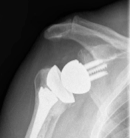Arm lengthening after reverse shoulder arthroplasty: a review.
These authors reviewed seven articles bearing on the issue of arm lengthening after reverse total shoulder arthroplasty. They found that changes in humeral length varied from minus five to five millimetres, and changes in upper-extremity length varied from 15 mm to 27 mm. Humeral and arm shortening increased the risk of dislocation and led to poor anterior active elevation. From this literature review the authors concluded that deltoid tensioning by restoring humeral length and increasing the acromiohumeral distance is critical for adequate postoperative function and to prevent dislocation. They caution against excessive arm lengthening to avoid postoperative neurological impairment.
There is no easy answer to "how much should the arm be lengthened by a reverse total shoulder?" Some shoulders having reverse total shoulders are chronically contracted in an upward position while others are very lax. The issues of presurgical pathoanatomy, bone quality, stability, arm lengthening, neurologic injury, function, acromial fractures, and prosthesis design are interrelated and complex. As an example one of the cases in this article had a preoperative acromial fracture making it difficult to tension the deltoid; the shoulder dislocated after surgery, but this problem could not have been prevented by increasing the lengthening of the arm. Furthermore, trying to achieve stability by tensioning the deltoid with the arm at the side does not provide stability when the arm is passively abducted away from the side (a position that reduces the deltoid tension). Lateral ("East-West") tensioning of the shoulder in addition to moving the arm distally ("South" tensioning) may provide more stability throughout the range of motion and reduce the risk to the acromion and brachial plexus from a distally tight reconstruction. The change in position of the humerus relative to the scapula depends on both the prosthesis design and the placement of the glenoid and humeral components in their respective bones.
Our practice is to carefully assess and discuss with the patient the bone structure, the bone quality, the residual cuff integrity, the neurological status and the joint laxity before surgery. At surgery, we attempt to balance the soft tissues and to achieve stability by East-West as well as South tensioning, avoiding over-tensioning the deltoid to minimize the risk of nerve damage and acromial fracture. Radiographic measurements of the amount of lengthening are helpful in clinical research, as shown by this review paper.
===
Consultation for those who live a distance away from Seattle.
**Check out the new (under construction) Shoulder Arthritis Book - click here.**
To see the topics covered in this Blog, click here
Consultation for those who live a distance away from Seattle.
To see the topics covered in this Blog, click here
Use the "Search" box to the right to find other topics of interest to you.
You may be interested in some of our most visited web pages including:shoulder arthritis, total shoulder, ream and run, reverse total shoulder, CTA arthroplasty, and rotator cuff surgery as well as the 'ream and run essentials'
You may be interested in some of our most visited web pages including:shoulder arthritis, total shoulder, ream and run, reverse total shoulder, CTA arthroplasty, and rotator cuff surgery as well as the 'ream and run essentials'

